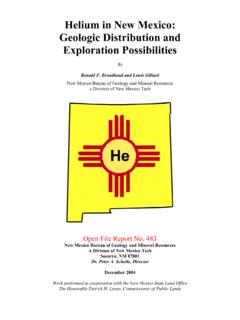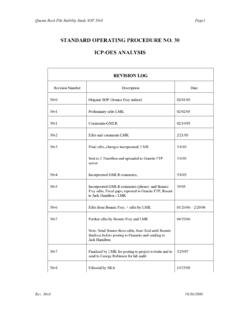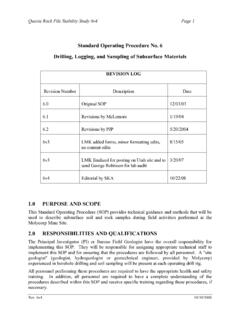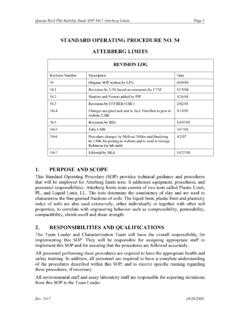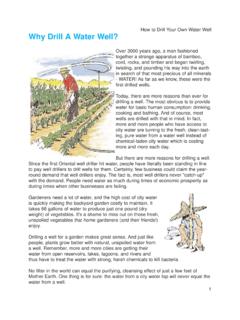Transcription of EDIBLE ROCKS II - New Mexico Institute of Mining and ...
1 EDIBLE ROCKS II Teacher Page This activity has been modified from a lesson plan for meteorite education from NASA. It has been refitted for more common ROCKS . The web site for the original lesson plan is and the original activity is courtesy NASA s "Exploring Meteorite Mysteries" NASA Publication EG-1997-08-104-HQ by Marilyn Lindstrom et al. Purpose: To observe and describe physical characteristics of a familiar model (candy bars) and apply to the unfamiliar ( ROCKS ). This is also an excellent activity to introduce geological terminology used in describing ROCKS .
2 Background: This activity fits in well with a unit on ROCKS and minerals. Examples of all three rock types, igneous, sedimentary and metamorphic, are all presented. Some teachers may be unfamiliar with a few of the descriptive terms used by geologists. A glossary of terms is listed in the rock description section, which you may want to share with students before or after the activity. The activity focuses strongly on the importance of observation, even of an item a child may see once, or several times (!), a week. Encourage them to look at textures, shapes and sizes of the materials.
3 Preparation: 1. Obtain the rock samples you wish to use (it is not necessary to use all examples). Obtain the corresponding EDIBLE samples. If you are using the garnetiferous schist in our kit, make the chopped peanut brittle, unless you have a nice sample of garnetiferous schist with BIG garnets! Then you can use store bought peanut brittle. 2. Cut the samples so that a flat, cut face exposes the interior (this works better with cold candy). Reserve part of each sample to be eaten by students afterwards (or have extra). 3. Place each sample in a small plastic bag or on a sheet of paper or cardboard.
4 Each team of two or three students will have one sample. 4. Give one student sheet to each team. 5. Cut apart the candy bar Field Note sample descriptions. These descriptions are written the way a geologist might take notes in a field record book. A nice way to do this is to glue the descriptions to foam board before cutting them out, they will last longer and look nicer. 6. Arrange the Field Note sample descriptions on a table with the corresponding rock so that students may attempt to match their own descriptions with these key descriptions.
5 Cut out the rock descriptions and place those next to or under the ROCKS . In Class: Distribute a sample and student sheet to each team. Note: Content vocabulary may not be expected initially. The processes of observing and recording should be kept simple. Explain that each team is responsible for describing and sketching its sample. Encourage teams to describe their observations using familiar vocabulary; however, use no food terms. Emphasize that working together is important. When finished, all students should go to the Field Note sample descriptions and rock samples which you have arranged on the key table.
6 Emphasize that their observations will not be exactly like the Field Notes . They will likely try several matches before they have the accurate pairing. Once they have the right one, require that they copy the correct answer key description onto their answer sheet while looking at their candy and the rock it is paired with. Reward the students with pieces of candy. Another option would be to have each team share their description and sketches with the class. Conduct a discussion that includes the following points which emphasize basic skills needed to be good scientists: (1) The students made detailed observations of a sample, (2) The task was accomplished by using teamwork, (3) Although the student s descriptions differed from those provided and each team has a different style, the skills and processes used to observe and record the data were the same for each group.
7 The students communicated and shared their observations and sketches. During the discussion of the observations, you may expand and discuss how the ROCKS formed, using geologic vocabulary and encouraging students to apply it to their own samples. *Recipe for Rock 6: Easy Chopped Peanut Brittle 2 Cups granulated sugar 1 Cup Karo Syrup (supposed to be white, use dark for activity) 1 tsp. baking soda. 1/2 lb. raw peanuts, chopped to near size of garnets Cook sugar and corn syrup over medium heat until sugar has melted. Pour in raw peanuts. Continue cooking until mixture forms a hard ball when dropped in cold water or just until syrup starts to turn an amber (about 15-20 mins.)
8 Add 1 tsp soda and stir well. Pour into lightly greased cookie sheet. DO NOT SPREAD OR TOUCH AT ALL. When cool, break into pieces. This recipe has been in the family for years and one of the best I have ever eaten. Pat, from Names: _____ _____ EDIBLE ROCKS Student Page Purpose: To observe and describe physical characteristics of a familiar model (candy bars) and apply to the unfamiliar ( ROCKS ). Background: Good observations set the foundation for good interpretations. The ability to carefully observe and describe things improves with practice.
9 Here is a chance to practice your observation skills on something you are already familiar with: candy bars! Can you describe the physical characteristics of these EDIBLE samples without using food terms? Could you or someone else identify the sample after reading your descriptions? Try it! Materials: Each team should obtain one prepared EDIBLE sample; sketch paper. Procedure: 1. Choose a sample to observe and describe. You may remove the sample from the bag, but handle it as little as possible to prevent melting. Do not taste it! 2. Make a detailed sketch of the sample on the sketch paper.
10 Draw what you see, not what you think it is. Show the interior and exterior details. You may label parts of the sketch, but do not use any food terms. 3. Write 2 to 3 sentences describing the physical characteristics of the interior and exterior of the sample on the back of this page. Do not use food terms. For example, do not use the word chocolate. Make your description as clear and complete as you possibly can. 4. How descriptive were you? If all the samples were placed in a row, could a classmate match your description to the correct sample?



